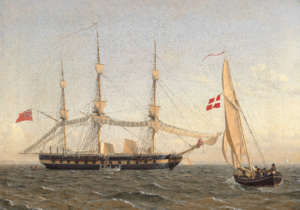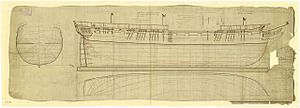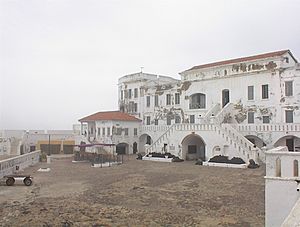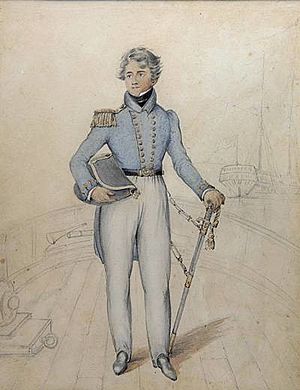HMS Owen Glendower (1808) facts for kids
class="infobox " style="float: right; clear: right; width: 315px; border-spacing: 2px; text-align: left; font-size: 90%;"
| colspan="2" style="text-align: center; font-size: 90%; line-height: 1.5em;" | 
|} The HMS Owen Glendower was a British warship, a type called a frigate, launched in 1808. It was a 36-gun ship, meaning it carried 36 cannons. This ship had a long life, serving until 1884.
During its time, the Owen Glendower helped capture a Danish island, fought in the Napoleonic Wars, sailed to far-off places like the East Indies and South America, and even helped stop the slave trade. Later, it served as a floating prison in Gibraltar before being sold.
Contents
| History | |
|---|---|
| Name | HMS Owen Glendower |
| Namesake | Owain Glyndŵr |
| Ordered | 1 October 1806 |
| Laid down | January 1807 |
| Launched | 19 November 1808 |
| Fate | Sold in 1884 |
| General characteristics | |
| Class and type | 36-gun fifth-rate Apollo-class frigate |
| Tons burthen | 9513⁄95 (bm) |
| Length |
|
| Beam | 38 ft 3+1⁄2 in (11.671 m) |
| Depth of hold | 13 ft 3 in (4.04 m) |
| Sail plan | Full-rigged ship |
| Complement | 285 |
| Armament |
|
- Exploring South America
- Atlantic Journeys
- Stopping the Slave Trade
- Service at the Cape of Good Hope
- Serving as a Prison Ship in Gibraltar
Adventures at Sea: Active Duty
Captain William Selby took command of the Owen Glendower in January 1809. The ship was ready for many important missions.
The Gunboat War: Capturing Anholt Island
In May 1809, the Owen Glendower joined a group of British ships. Their mission was to capture the Danish island of Anholt. This island was small but important because it had a lighthouse. The Danes had turned off the lighthouse during the war. The British wanted to turn it back on to help their ships navigate.
A team of sailors and marines landed on the island. The Danish soldiers tried to fight back but quickly surrendered. On May 18, the British took control of Anholt Island.
Patrolling the English Channel
From late 1809, the Owen Glendower patrolled the English Channel. On March 10, 1810, the ship found a French privateer, a ship that attacked merchant vessels. The French ship, named Camille, was trying to capture an English schooner. Captain Selby chased Camille for a long time. The French ship fought until it was badly damaged. Camille had 58 crew members, with two killed and three wounded. It had sailed from Cherbourg just hours before and had already captured an English ship called Fame.
On October 1, the Owen Glendower, along with another ship called Persian, was protecting a group of merchant ships near The Lizard. In thick fog, a French privateer cutter attacked one of the convoy ships, Roden. When the fog cleared, the cutter was close by. It was a 16-gun ship called Indomptable. The Owen Glendower fired its cannons, and the French ship surrendered. Captain Selby also rescued the Roden.
Sadly, Captain Selby died on board the Owen Glendower on March 28, 1811, while at the Cape of Good Hope.
Journeys to the East Indies
The Owen Glendower began its next long journey to the East Indies. It sailed from England on October 20, 1811. In 1812, it served as the main ship for Vice Admiral Sir Samuel Hood in the East Indies.
In May 1814, near the Nicobar Islands, the Owen Glendower captured an American privateer ship called Hyder Ally. This ship had 16 cannons and a crew of 30. Hyder Ally had already captured three British ships, but the British later got them back.
The Owen Glendower visited many places in the East Indies, including Malacca, Madras, and China. The ship returned to England in the spring of 1816 and was put away for repairs.
Life After War: Post-War Service
The Owen Glendower underwent major repairs between March 1817 and May 1819. After that, it was prepared for sea again.
Exploring South America
Captain the Honorable Robert Cavendish Spencer took command of the Owen Glendower in August 1819. He spent two and a half months getting the ship ready.
The Owen Glendower sailed for South America on November 16. It arrived in Rio de Janeiro in just 33 days, which was very fast for the time. The ship then sailed to Montevideo and Buenos Aires.
Later, the Owen Glendower sailed to St Helena to check on Napoleon, who was held captive there. Captain Spencer reported that Napoleon was treated well. While the Owen Glendower was away, another admiral made a different ship his flagship.
The Owen Glendower then sailed around Cape Horn and arrived in Valparaiso on January 22, 1821. Captain Spencer was ordered to find Captain William Henry Shirreff of another ship, Andromache. Shirreff had ignored orders to return to Britain. Spain had complained that Shirreff was not staying neutral in a conflict. Spencer found Andromache and Shirreff agreed to return to Britain.
The Owen Glendower spent three months near Spanish Peru, visiting the Galapagos Islands. A young sailor on board, Robert FitzRoy, later became famous as the captain of the HMS Beagle, which carried Charles Darwin to the Galapagos. While the Owen Glendower was at Callao, the Chilean fleet attacked the port. The negotiations between Spain and the rebels took place on the Owen Glendower. These talks led to the creation of the Republic of Peru.
The Owen Glendower sailed back to England with valuable cargo. It arrived at Spithead on January 19, 1822.
Atlantic Journeys
After more repairs, the Owen Glendower sailed to Copenhagen. It carried Earl Spencer, Captain Spencer's father, to invest the Danish King with a special honor called the Order of the Garter. The ship then sailed to Falmouth and Madeira to measure their exact locations. After these missions, the ship was put out of service for a while.
Another young sailor on the Owen Glendower at this time was Richard Brydges Beechey. He later became a Rear Admiral and was also a famous painter.
Stopping the Slave Trade
In October 1821, Captain Sir Robert Mends was put in charge of the West Africa Squadron. This group of ships worked to stop the illegal slave trade on the west coast of Africa. He took command of the Owen Glendower in November 1822.
On June 16, 1823, the Owen Glendower captured a Spanish slave ship called Concheta.
Captain Mends later became ill with cholera and died on September 4. The very next day, on September 5, the boats from the Owen Glendower captured another Spanish slave ship, Fabiana.
In February 1824, marines from the Owen Glendower helped defend Cape Coast Castle after the Ashanti defeated government forces. The ship also visited other ports to help keep peace.
One of the officers on the Owen Glendower during this time was Cheesman Henry Binstead. He kept detailed diaries about life on the ship, describing chasing slave ships, fears of attack, and the effects of illness on the crew. When the Owen Glendower finally returned to England, Binstead was one of the few original crew members who had survived.
The Owen Glendower was refitted again from October 1824 to February 1825. Captain Hood Hanway Christian then took command and sailed it back to Africa.
Service at the Cape of Good Hope
From early 1825 to early 1827, the Owen Glendower was based at the Cape of Good Hope. Sadly, on March 10, 1826, 19 sailors from the ship drowned in a boating accident at Simon's Bay. After another trip to England, the ship was put out of service in July. It underwent more repairs between December 1828 and December 1829.
Serving as a Prison Ship in Gibraltar
In March 1842, the Owen Glendower was prepared to become a prison hulk in Gibraltar. A prison hulk was an old ship used as a floating prison.
In October, the ship sailed from Chatham to Gibraltar with about 200 people who had broken laws. These people were sent to work on building a new dockyard and breakwater. Among them were the Tolpuddle Martyrs, who were sent there because of unfair laws about workers' rights. The Owen Glendower then served as a prison ship for many decades.
The End of a Long Journey
In 1876, the prison system in Gibraltar changed. The Owen Glendower, which had been used as the convicts' hospital, became a receiving ship. Finally, in 1884, the ship was sold in Gibraltar for £1036.
|




